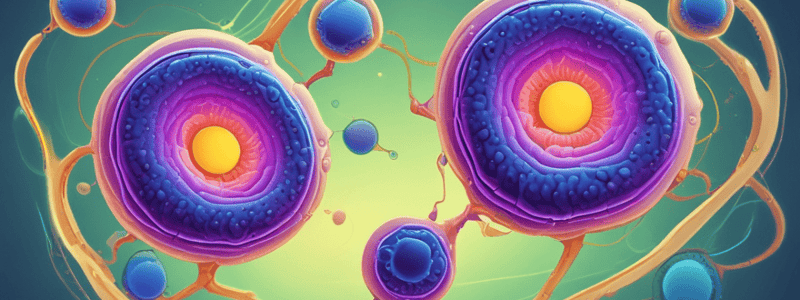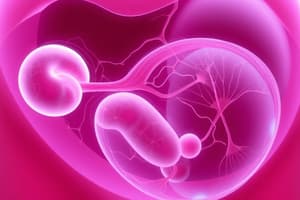Podcast
Questions and Answers
What is the primary function of gonads in the reproductive system?
What is the primary function of gonads in the reproductive system?
- Producing hormones to regulate sleep
- Producing gametes (correct)
- Regulating body temperature
- Storing genetic information
What is the name of the cells that eventually become gametes?
What is the name of the cells that eventually become gametes?
- Spermatogonia
- Oogonia
- Germ cells (correct)
- Spermatozoa
Where do primordial germ cells arise from?
Where do primordial germ cells arise from?
- Anterior pituitary gland
- Posterior yolk sac (correct)
- Genital ridge
- Seminiferous tubules
What is the term for the process by which diploid spermatogonia proliferate by mitotic cell division?
What is the term for the process by which diploid spermatogonia proliferate by mitotic cell division?
What is the primary function of Sertoli cells in the seminiferous tubules?
What is the primary function of Sertoli cells in the seminiferous tubules?
What is the stage of spermatogenesis where spermatogonia enter meiosis?
What is the stage of spermatogenesis where spermatogonia enter meiosis?
Where do Leydig cells reside in the testes?
Where do Leydig cells reside in the testes?
What is the result of meiosis-2 in spermatogenesis?
What is the result of meiosis-2 in spermatogenesis?
What happens to sperm as they pass through the epididymis?
What happens to sperm as they pass through the epididymis?
What is the function of the acrosome in spermatozoa?
What is the function of the acrosome in spermatozoa?
During embryogenesis, when do primordial germ cells migrate to the ovaries?
During embryogenesis, when do primordial germ cells migrate to the ovaries?
What is the process by which excess cytoplasm is removed from spermatids?
What is the process by which excess cytoplasm is removed from spermatids?
What is the approximate number of primordial follicles present in the ovaries at birth?
What is the approximate number of primordial follicles present in the ovaries at birth?
What is the structure that is responsible for the movement of spermatozoa?
What is the structure that is responsible for the movement of spermatozoa?
During puberty, what happens to the primordial follicles?
During puberty, what happens to the primordial follicles?
What is the term for the tubes that make up the testis?
What is the term for the tubes that make up the testis?
What is the term for the process of sperm release from Sertoli cells?
What is the term for the process of sperm release from Sertoli cells?
What is the purpose of Sertoli cells acting as phagocytes?
What is the purpose of Sertoli cells acting as phagocytes?
How long does it take for sperm to pass through the epididymis?
How long does it take for sperm to pass through the epididymis?
What is the result of Meiosis-1 in oogenesis?
What is the result of Meiosis-1 in oogenesis?
What is the primary function of the fimbriae in the uterine tube?
What is the primary function of the fimbriae in the uterine tube?
During which stage of the menstrual cycle does the level of FSH experience a slight increase?
During which stage of the menstrual cycle does the level of FSH experience a slight increase?
What is the name of the enzyme used by the sperm to penetrate the zona pellucida during fertilization?
What is the name of the enzyme used by the sperm to penetrate the zona pellucida during fertilization?
At which stage of fertilization does the sperm migrate through the follicular cells?
At which stage of fertilization does the sperm migrate through the follicular cells?
What is the name of the inner cell mass formed during the blastocyst stage?
What is the name of the inner cell mass formed during the blastocyst stage?
What is the outer layer of the egg called?
What is the outer layer of the egg called?
During which day of the menstrual cycle does ovulation occur?
During which day of the menstrual cycle does ovulation occur?
What is the name of the structure that leads to the body of the uterus?
What is the name of the structure that leads to the body of the uterus?
What is the percentage of sperm that reach the oocytes during fertilization?
What is the percentage of sperm that reach the oocytes during fertilization?
What is the name of the stage during which the blastocyst comes out of the zona pellucida?
What is the name of the stage during which the blastocyst comes out of the zona pellucida?
What is the primary function of the fimbriae in the uterine tube?
What is the primary function of the fimbriae in the uterine tube?
During which stage of the menstrual cycle does ovulation occur?
During which stage of the menstrual cycle does ovulation occur?
What is the name of the enzyme used by the sperm to penetrate the zona pellucida during fertilization?
What is the name of the enzyme used by the sperm to penetrate the zona pellucida during fertilization?
What is the term for the process by which the blastocyst comes out of the zona pellucida?
What is the term for the process by which the blastocyst comes out of the zona pellucida?
What is the result of fertilization?
What is the result of fertilization?
What is the structure that leads to the body of the uterus?
What is the structure that leads to the body of the uterus?
What is the percentage of sperm that reach the oocytes during fertilization?
What is the percentage of sperm that reach the oocytes during fertilization?
During which stage of embryogenesis do primordial germ cells migrate to the gonads?
During which stage of embryogenesis do primordial germ cells migrate to the gonads?
What is the term for the layer of cells that surrounds the oocyte?
What is the term for the layer of cells that surrounds the oocyte?
During which stage of fertilization does the sperm migrate through the follicular cells?
During which stage of fertilization does the sperm migrate through the follicular cells?
What is the result of meiosis-1 in spermatogenesis?
What is the result of meiosis-1 in spermatogenesis?
What is the primary function of Sertoli cells in relation to spermatogenesis?
What is the primary function of Sertoli cells in relation to spermatogenesis?
What is the name of the inner cell mass formed during the blastocyst stage?
What is the name of the inner cell mass formed during the blastocyst stage?
In which structure do diploid spermatogonia proliferate by mitotic cell division?
In which structure do diploid spermatogonia proliferate by mitotic cell division?
What is the function of the mitochondria gathered at the midpiece of the sperm?
What is the function of the mitochondria gathered at the midpiece of the sperm?
Where do oogonia proliferate via mitotic cell division?
Where do oogonia proliferate via mitotic cell division?
What is the result of spermatids differentiating into spermatozoa?
What is the result of spermatids differentiating into spermatozoa?
What happens to sperm as they pass through the epididymis?
What happens to sperm as they pass through the epididymis?
During which stage of spermatogenesis do Spermatogonia enter meiosis?
During which stage of spermatogenesis do Spermatogonia enter meiosis?
What is the result of Meiosis-1 in oogenesis?
What is the result of Meiosis-1 in oogenesis?
What is the function of Leydig cells?
What is the function of Leydig cells?
What is the structure responsible for the movement of spermatozoa?
What is the structure responsible for the movement of spermatozoa?
What is the function of the acrosome in spermatozoa?
What is the function of the acrosome in spermatozoa?
What is the term for the process of sperm release from Sertoli cells?
What is the term for the process of sperm release from Sertoli cells?
During which stage of spermatogenesis do Spermatids differentiate into spermatozoa?
During which stage of spermatogenesis do Spermatids differentiate into spermatozoa?
How long does it take for sperm to pass through the epididymis?
How long does it take for sperm to pass through the epididymis?
What is the term for the tubes that make up the testis?
What is the term for the tubes that make up the testis?
What happens to excess cytoplasm during spermatogenesis?
What happens to excess cytoplasm during spermatogenesis?
What is the approximative number of primordial follicles present in the ovaries at birth?
What is the approximative number of primordial follicles present in the ovaries at birth?
During which stage of embryogenesis do primordial germ cells migrate to the ovaries?
During which stage of embryogenesis do primordial germ cells migrate to the ovaries?
Study Notes
Reproductive System
- Gonad: an organ where gametes are produced (e.g., testis and ovaries) and controls sexual characteristics via hormones.
- Germ cells: cells that become gametes, often indicated by cells before meiosis (e.g., spermatogonia and oogonia).
Origin of Germ Cells
- Primordial germ cells (PGCs) arise from the posterior yolk sac and migrate to the gonads (future testis or ovaries) during embryogenesis.
Spermatogenesis
- PGCs form 3-6 weeks into embryogenesis and migrate to the gonads 2-3 months into embryogenesis.
- At puberty, spermatogonia occurs, and seminiferous tubules in the testis mature, allowing spermatogonia to further proliferate and enter meiosis.
- Diploid spermatogonia proliferate by mitotic cell division inside the testis.
- Spermatogonia enter meiosis, becoming secondary spermatocytes and then spermatids.
- Spermatids finally differentiate into spermatozoa (sperm) through a process involving:
- Nucleus condensation
- Formation of acrosome (head) and flagellum
- Mitochondria gathering at the midpiece
- Removal of excess cytoplasm
Sertoli Cells
- Span from the basement membrane to the lumen, surrounding differentiating spermatogonia.
- Produce enzymes and growth factors required for spermatogenesis.
- Function as phagocytes to clean up residual cytoplasm of sperm.
- Spermatogenesis takes place in close relation to Sertoli cells.
Leydig Cells (Interstitial Cells)
- Reside outside seminiferous tubules.
- Secrete testosterone in response to luteinizing hormone (LH).
- Sperms are released to the lumen and transferred to the epididymis.
Epididymis
- Reservoir of sperm with a passage taking 1-21 days.
- Concentrates fluid by 100x.
- Long single duct with peristaltic contraction.
- Sperm undergoes further maturation, acquiring mobility, and increasing dependence on fructose for energy production.
Oogenesis
- Primordial germ cells (PGCs) form 3-6 weeks into embryogenesis and migrate to the gonads (future ovaries) 6-12 weeks into embryogenesis.
- Oogonia proliferate via mitotic cell division inside ovaries.
- After 12 weeks of embryogenesis, oogonium enters meiosis-1's prophase and becomes a primary oocyte.
- Follicular cells in the ovary surround the oocyte, forming the primordial follicle.
- At puberty, a few primordial follicles re-commence meiosis every day, with only one ovulated per month.
Maturation of Follicles
- Primordial follicle, with flat follicular cells.
- Primary follicle, with multi-layer follicular cells.
- Secondary follicle with antrum.
- Secondary follicle with antrum and "Graafian follicle".
Menstrual Cycle
- Pituitary hormones: LH reaches peak during ovulation, and FSH levels remain steady throughout, with slight increases during maturing follicle stage.
- Ovarian hormones: progestogen increases gradually during the secretory phase, and oestrogen fluctuates, increasing at the end of the proliferation phase and decreasing till day 14.
- Ovulation occurs on day 14.
Uterus
- Consists of two uterine tubes that lead to the body with a back wall called the fundus.
- The inner wall of the uterus is called the endometrium, with the cervix being the entrance to the body.
Ovulation
- Ovum is collected by the trumpet-shaped distal end of the uterine tube (infundibulum) with fimbriae (finger-like projections).
Fertilisation
- Can occur at the ampulla (the curve at the uterine tube).
- Out of 300 million sperm, only 200 reach oocytes.
- Sperm must migrate through follicular cells (corona radiata), zona pellucida, using enzyme kin acrosome, and finally fuse with the membrane of the oocyte.
- The fertilised egg travels to the uterus.
Implantation
- The fertilised egg travels to the uterus, and by day 4, it is 8 cells and at the end of the uterine tube.
- By day 5, an early blastocyst forms, and by day 7, hatching occurs where the blastocyst comes out of zona pellucida.
- Implantation occurs on day 8-9.
Reproductive System
- Gonad: an organ where gametes are produced (e.g., testis and ovaries) and controls sexual characteristics via hormones.
- Germ cells: cells that become gametes, often indicated by cells before meiosis (e.g., spermatogonia and oogonia).
Origin of Germ Cells
- Primordial germ cells (PGCs) arise from the posterior yolk sac and migrate to the gonads (future testis or ovaries) during embryogenesis.
Spermatogenesis
- PGCs form 3-6 weeks into embryogenesis and migrate to the gonads 2-3 months into embryogenesis.
- At puberty, spermatogonia occurs, and seminiferous tubules in the testis mature, allowing spermatogonia to further proliferate and enter meiosis.
- Diploid spermatogonia proliferate by mitotic cell division inside the testis.
- Spermatogonia enter meiosis, becoming secondary spermatocytes and then spermatids.
- Spermatids finally differentiate into spermatozoa (sperm) through a process involving:
- Nucleus condensation
- Formation of acrosome (head) and flagellum
- Mitochondria gathering at the midpiece
- Removal of excess cytoplasm
Sertoli Cells
- Span from the basement membrane to the lumen, surrounding differentiating spermatogonia.
- Produce enzymes and growth factors required for spermatogenesis.
- Function as phagocytes to clean up residual cytoplasm of sperm.
- Spermatogenesis takes place in close relation to Sertoli cells.
Leydig Cells (Interstitial Cells)
- Reside outside seminiferous tubules.
- Secrete testosterone in response to luteinizing hormone (LH).
- Sperms are released to the lumen and transferred to the epididymis.
Epididymis
- Reservoir of sperm with a passage taking 1-21 days.
- Concentrates fluid by 100x.
- Long single duct with peristaltic contraction.
- Sperm undergoes further maturation, acquiring mobility, and increasing dependence on fructose for energy production.
Oogenesis
- Primordial germ cells (PGCs) form 3-6 weeks into embryogenesis and migrate to the gonads (future ovaries) 6-12 weeks into embryogenesis.
- Oogonia proliferate via mitotic cell division inside ovaries.
- After 12 weeks of embryogenesis, oogonium enters meiosis-1's prophase and becomes a primary oocyte.
- Follicular cells in the ovary surround the oocyte, forming the primordial follicle.
- At puberty, a few primordial follicles re-commence meiosis every day, with only one ovulated per month.
Maturation of Follicles
- Primordial follicle, with flat follicular cells.
- Primary follicle, with multi-layer follicular cells.
- Secondary follicle with antrum.
- Secondary follicle with antrum and "Graafian follicle".
Menstrual Cycle
- Pituitary hormones: LH reaches peak during ovulation, and FSH levels remain steady throughout, with slight increases during maturing follicle stage.
- Ovarian hormones: progestogen increases gradually during the secretory phase, and oestrogen fluctuates, increasing at the end of the proliferation phase and decreasing till day 14.
- Ovulation occurs on day 14.
Uterus
- Consists of two uterine tubes that lead to the body with a back wall called the fundus.
- The inner wall of the uterus is called the endometrium, with the cervix being the entrance to the body.
Ovulation
- Ovum is collected by the trumpet-shaped distal end of the uterine tube (infundibulum) with fimbriae (finger-like projections).
Fertilisation
- Can occur at the ampulla (the curve at the uterine tube).
- Out of 300 million sperm, only 200 reach oocytes.
- Sperm must migrate through follicular cells (corona radiata), zona pellucida, using enzyme kin acrosome, and finally fuse with the membrane of the oocyte.
- The fertilised egg travels to the uterus.
Implantation
- The fertilised egg travels to the uterus, and by day 4, it is 8 cells and at the end of the uterine tube.
- By day 5, an early blastocyst forms, and by day 7, hatching occurs where the blastocyst comes out of zona pellucida.
- Implantation occurs on day 8-9.
Studying That Suits You
Use AI to generate personalized quizzes and flashcards to suit your learning preferences.
Related Documents
Description
Learn about the reproductive system, specifically gonads and germ cells, including their functions and development from primordial germ cells.




